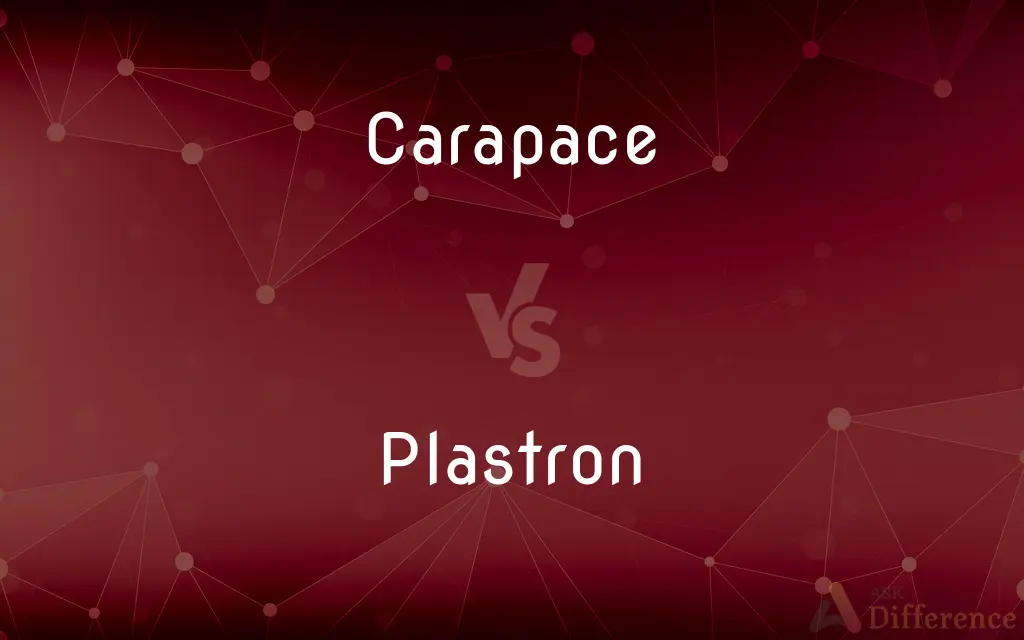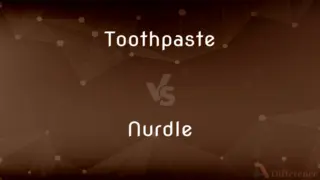Carapace vs. Plastron — What's the Difference?
By Tayyaba Rehman — Updated on October 3, 2023
The carapace is the dorsal (top) shell of turtles, crustaceans, and some arachnids, while the plastron is the ventral (bottom) shell in turtles. Both provide protection.

Difference Between Carapace and Plastron
Table of Contents
ADVERTISEMENT
Key Differences
The carapace and plastron are protective anatomical structures found primarily in turtles and tortoises. The carapace, the top part of the shell, serves as a shield for the creature's back and sides. This dorsal shield is crucial for the protection of vital organs and adds rigidity to the creature's frame. On the other hand, the plastron offers protection to the underside of these animals.
In addition to turtles and tortoises, the term "carapace" is also employed in describing certain other animals. Crustaceans like crabs and lobsters possess a carapace, which provides armor-like protection to their upper bodies. However, the term "plastron" remains exclusive to the ventral shield in turtles and is not commonly used for other animals.
Both the carapace and plastron are made up of bony plates that develop within the skin. These plates fuse as the animal grows, forming a solid protective layer. While the carapace typically consists of a larger number of these plates, the plastron has fewer, but they serve the same critical protective function.
Coloration and patterns can vary widely across both the carapace and plastron. These patterns often serve as camouflage, helping the animal blend into its environment. However, it's essential to understand that while the carapace is generally more exposed and prone to damage, the plastron, being on the underside, remains relatively shielded and can be softer in some species.
Comparison Chart
Position
Dorsal (top) part of the shell
Ventral (bottom) part of the shell
ADVERTISEMENT
Found In
Turtles, some crustaceans, some arachnids
Primarily in turtles
Function
Protects the back and sides
Protects the underside
Composition
Made of bony plates
Made of bony plates
Exposure
More exposed, can be more robust
Less exposed, can be softer in some species
Compare with Definitions
Carapace
A protective shield covering the back of some animals.
The intricate patterns on the turtle's carapace helped it camouflage.
Plastron
The ventral shell of turtles.
The turtle's plastron was smooth and slightly concave.
Carapace
The dorsal shell of turtles, crustaceans, and some arachnids.
The crab's carapace was tough and provided ample protection.
Plastron
The protective underside component in chelonian creatures.
Each species has a unique pattern on its plastron that helps in identification.
Carapace
The upper exoskeleton in certain creatures.
You could identify the species by the markings on its carapace.
Plastron
The lower exoskeleton in turtles and tortoises.
The color of the plastron can vary widely among turtle species.
Carapace
A rigid structural component on the upper side of certain animals.
The carapace of some turtles can withstand significant pressure.
Plastron
The bony plate protecting the belly of turtles.
Unlike its hard carapace, the turtle's plastron was relatively softer.
Carapace
A carapace is a dorsal (upper) section of the exoskeleton or shell in a number of animal groups, including arthropods, such as crustaceans and arachnids, as well as vertebrates, such as turtles and tortoises. In turtles and tortoises, the underside is called the plastron.
Plastron
A metal breastplate worn under a coat of mail.
Carapace
(Zoology) A hard bony or chitinous outer covering, such as the fused dorsal plates of a turtle or the portion of the exoskeleton covering the head and thorax of a crustacean.
Plastron
A quilted pad worn by fencers to protect the torso and side.
Carapace
A protective, shell-like covering likened to that of a turtle or crustacean
"He used to worry that Sarah would age the same way, develop the same brittle carapace" (Anne Tyler).
Plastron
A trimming on the front of a bodice.
Carapace
A hard protective covering of bone or chitin, especially one which covers the dorsal portion of an animal.
Plastron
The front of a man's dress shirt.
Carapace
In figurative use
Plastron
The front panel of the tunic of a uniform, usually of a different color than the rest.
Carapace
The thick shell or shield which covers the back of the tortoise, or turtle, the crab, and other crustaceous animals.
Plastron
(Zoology) The ventral part of the shell of a turtle or tortoise.
Carapace
Hard outer covering or case of certain organisms such as arthropods and turtles
Plastron
The nearly flat part of the shell structure of a tortoise or other animal, similar in composition to the carapace.
Carapace
The bony external plate offering protection to some aquatic animals.
Researchers studied the strength and resilience of the lobster's carapace.
Plastron
(fencing) A half-jacket worn under the jacket for padding or for safety.
Plastron
A man's shirt-bosom.
Plastron
An ornamental front panel on a woman's bodice.
Plastron
A breastplate.
Plastron
A film of air trapped by specialized hairs against the body of an aquatic insect, and which acts as an external gill.
The plastron of a diving beetle is not directly a source of oxygen, but acts as a gill, acquiring oxygen from the surrounding water.
Plastron
A piece of leather stuffed or padded, worn by fencers to protect the breast.
Plastron
An iron breastplate, worn under the hauberk.
Plastron
The ventral shield or shell of tortoises and turtles. See Testudinata.
Plastron
A trimming for the front of a woman's dress, made of a different material, and narrowing from the shoulders to the waist.
Plastron
The ornamental front of a woman's bodice or shirt
Plastron
The front of man's dress shirt
Plastron
A metal breastplate that was worn under a coat of mail
Plastron
A large pad worn by a fencer to protect the chest
Plastron
(zoology) the part of a turtle's shell forming its underside
Plastron
The underside protective shield in chelonians.
He gently turned the turtle over to examine its plastron.
Common Curiosities
What is the purpose of the plastron?
The plastron is the ventral (bottom) shell of turtles, protecting their underside.
Is the plastron exclusive to turtles?
Yes, the term "plastron" is primarily used for the underside shell of turtles.
Can the carapace help in species identification?
Yes, the patterns and markings on the carapace can help identify different species.
Can the carapace be soft?
While most are hard, some turtles, like soft-shelled turtles, have a softer carapace.
What is a carapace?
The carapace is the dorsal (top) shell of turtles, crustaceans, and some arachnids.
Are carapace and plastron found in all turtles?
Yes, all turtles and tortoises have both a carapace and a plastron.
Do carapace and plastron serve as a defense mechanism?
Yes, both provide protection against predators and environmental hazards.
How do carapace and plastron develop?
They develop from bony plates that fuse as the animal grows.
Is the carapace always hard and rigid?
While most carapaces are hard, some turtles, like soft-shelled turtles, have a flexible carapace.
Why is the plastron often softer than the carapace?
Being on the underside, the plastron is less exposed to potential threats, allowing it to be softer in some species.
What animals besides turtles have a carapace?
Crustaceans like crabs and lobsters, and some arachnids have a carapace.
Are carapace and plastron made of the same material?
Both are made of bony plates, though their texture and robustness might differ.
Can the color of the plastron change?
Yes, in some species, the plastron's color can change due to factors like age or diet.
Can carapace or plastron regenerate if damaged?
They can heal over time, but significant damage might leave permanent scars or deformities.
Which is more robust, carapace or plastron?
Generally, the carapace is more robust due to its exposure, but it varies among species.
Share Your Discovery

Previous Comparison
Automation vs. Automatization
Next Comparison
Toothpaste vs. NurdleAuthor Spotlight
Written by
Tayyaba RehmanTayyaba Rehman is a distinguished writer, currently serving as a primary contributor to askdifference.com. As a researcher in semantics and etymology, Tayyaba's passion for the complexity of languages and their distinctions has found a perfect home on the platform. Tayyaba delves into the intricacies of language, distinguishing between commonly confused words and phrases, thereby providing clarity for readers worldwide.














































